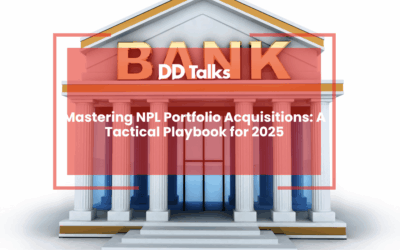Key Takeaways
- NPL securitization transforms illiquid non-performing loans into marketable securities through special purpose vehicles (SPVs), creating tranched securities with different risk-return profiles.
- The European NPL securitization market has matured significantly since 2008, with government programs like Italy’s GACS and Greece’s Hercules scheme catalyzing market growth.
- Typical NPL securitization structures employ waterfall payment systems, credit enhancements, and specialized servicing strategies to manage the inherent uncertainty in NPL recoveries.
- The regulatory framework has evolved to better accommodate NPL securitizations, with specific amendments addressing risk retention requirements and capital treatment.
- Banks benefit from NPL securitization through regulatory capital relief, liquidity enhancement, improved balance sheet metrics, and more efficient NPL management.
- Key risks in NPL securitizations include valuation uncertainty, servicing quality, legal complexities, and market liquidity challenges.
- The investor base spans from risk-averse institutional investors in senior tranches to specialized distressed debt funds in junior positions.
- Future trends include digital transformation of NPL management, increasing ESG considerations, greater standardization, and potential growth in cross-border transactions.
Table of Contents
- Understanding NPL Securitization: Core Concepts and Mechanisms
- The Evolution of European NPL Securitization Markets Since 2008
- How Do NPL Securitization Structures Work in Practice?
- Regulatory Framework: Navigating European NPL Securitization Rules
- Key Benefits of NPL Securitization for European Banks
- Managing Risks in Non-Performing Loan Securitization Transactions
- Investment Opportunities: Who Participates in the NPL ABS Market?
- Future Outlook: Emerging Trends in European NPL Securitization
Understanding NPL Securitization: Core Concepts and Mechanisms
NPL securitization represents a sophisticated financial mechanism that enables banks to transform non-performing loans into marketable securities. At its core, this process involves pooling together non-performing loans with similar characteristics and transferring them to a special purpose vehicle (SPV), which then issues asset-backed securities (ABS) to investors. These securities are backed by the cash flows generated from the recovery of the underlying non-performing loans.
The NPL securitization process in Europe typically involves several key participants: the originator (usually a bank with NPLs on its balance sheet), the SPV, servicers who manage the recovery process, and investors who purchase the resulting securities. The securities are typically structured in tranches with different risk-return profiles, allowing for broader market participation across the risk spectrum.
What distinguishes NPL securitization from standard securitization is the inherent uncertainty in cash flows. Unlike performing loans with predictable payment schedules, NPLs require intensive servicing efforts to recover value, making the timing and amount of recoveries less predictable. This uncertainty necessitates sophisticated pricing models and robust credit enhancement mechanisms to make the resulting securities attractive to investors.
The fundamental appeal of NPL securitization lies in its ability to transform illiquid, problematic assets into tradable securities, thereby enhancing market liquidity and enabling more efficient capital allocation within the European banking sector.
The Evolution of European NPL Securitization Markets Since 2008
The European NPL securitization market has undergone significant transformation since the 2008 global financial crisis. In the immediate aftermath of the crisis, European banks faced mounting pressure as NPL ratios soared, particularly in southern European economies like Italy, Spain, Greece, and Portugal. Initially, regulatory uncertainty and investor scepticism limited the development of a robust NPL securitization market.
The turning point came around 2015-2016 when European authorities recognised the urgent need to address the NPL problem that was hampering economic recovery. Italy’s GACS (Garanzia Cartolarizzazione Sofferenze) scheme, introduced in 2016, represented a watershed moment, providing state guarantees for senior tranches of NPL securitizations and catalysing market activity. Similarly, Greece’s Hercules programme, modelled after GACS, helped Greek banks substantially reduce their NPL burdens.
Transaction volumes have grown substantially, with Italy and Spain leading the European NPL securitization market. The investor base has also evolved, with specialised credit funds and institutional investors developing expertise in valuing and managing NPL exposures. Pricing mechanisms have become more sophisticated, incorporating advanced recovery models and granular loan-level analysis.
The COVID-19 pandemic initially disrupted market activity but also accelerated digitalisation in NPL management and created new opportunities as fresh NPL volumes emerged. By 2023, the European NPL securitization market had matured considerably, with standardised structures, improved data quality, and greater market transparency contributing to a more efficient marketplace for distressed debt.
How Do NPL Securitization Structures Work in Practice?
NPL securitization structures in Europe have evolved to address the unique challenges posed by non-performing loans. A typical transaction begins with the selection of an NPL portfolio, which undergoes thorough due diligence to assess recovery potential. The originating bank then transfers this portfolio to an SPV, which issues securities backed by the expected recoveries.
The securities are commonly structured in a waterfall payment system with multiple tranches. The senior tranche, which has first claim on cash flows, typically receives investment-grade ratings and attracts risk-averse investors. Mezzanine tranches offer higher yields with moderate risk, while junior tranches (often retained by the originator) absorb first losses but potentially deliver the highest returns if recoveries exceed expectations.
Credit enhancement mechanisms are crucial in NPL securitization structures. These include overcollateralization (where the face value of the NPL portfolio exceeds the value of issued securities), reserve accounts, excess spread arrangements, and in some cases, government guarantees like those provided under Italy’s GACS or Greece’s Hercules programmes.
The servicing strategy represents another critical component. Specialized servicers are appointed to manage the recovery process, employing various approaches from loan restructuring to legal enforcement and property liquidation. Performance-based servicing fees align the servicer’s interests with those of investors, incentivising maximum recovery values.
Cash flow distribution follows predetermined rules, with recoveries first covering servicing costs and senior tranche payments before flowing to lower tranches. This structural protection helps mitigate the inherent uncertainty in NPL recoveries, making the resulting securities more attractive to a broader range of investors.
Regulatory Framework: Navigating European NPL Securitization Rules
The regulatory landscape for NPL securitization in Europe has evolved significantly, creating a more structured framework while attempting to balance financial stability concerns with the need for efficient NPL resolution. The EU Securitisation Regulation, which came into effect in January 2019, established a comprehensive set of rules applicable to all securitizations, including those involving NPLs.
In 2021, the European Commission introduced amendments specifically addressing NPL securitizations, recognising their unique characteristics compared to performing loan securitizations. These amendments modified risk retention requirements, allowing the servicer to fulfil the 5% risk retention obligation in certain circumstances, acknowledging the crucial role servicers play in NPL transactions.
Capital requirements for banks investing in NPL securitizations have been recalibrated under the Capital Requirements Regulation (CRR) to better reflect the actual risk profile of these investments. This has removed some disincentives that previously limited institutional participation in the market.
Disclosure requirements under the European NPL securitization regulations demand extensive loan-level data, transaction documentation, and regular performance reporting. While these requirements enhance transparency, they also impose significant operational burdens on originators and servicers.
National frameworks complement the EU-level regulations, with countries like Italy, Greece, and Spain implementing specific schemes to facilitate NPL securitization. These often include tax incentives, streamlined foreclosure procedures, and in some cases, state guarantees for senior tranches, which have proven instrumental in developing active NPL securitization markets in these jurisdictions.
Navigating this complex regulatory landscape requires specialised expertise, but the increased regulatory clarity has ultimately contributed to a more mature and efficient European NPL securitization market.
Key Benefits of NPL Securitization for European Banks
NPL securitization offers European banks a strategic tool for balance sheet management with multiple advantages. Foremost among these is the ability to achieve significant regulatory capital relief. By transferring NPLs off their balance sheets, banks can reduce risk-weighted assets and improve key regulatory ratios, including the Common Equity Tier 1 (CET1) ratio. This capital liberation enables banks to redirect resources toward new lending activities, supporting economic growth.
Liquidity enhancement represents another crucial benefit. NPL securitization transforms illiquid problem loans into cash proceeds, improving banks’ liquidity positions and funding profiles. This is particularly valuable for banks facing funding constraints or seeking to optimise their liquidity coverage ratios under Basel III requirements.
The process also facilitates more efficient NPL portfolio management. Rather than maintaining large internal workout teams, banks can leverage the expertise of specialised servicers through securitization structures. This often results in improved recovery rates and reduced operational costs associated with NPL management.
From an accounting perspective, NPL securitization can help banks achieve true-sale treatment, allowing for the derecognition of problematic assets from their balance sheets. This improves key performance indicators such as return on assets and non-performing loan ratios, potentially leading to improved market perception and lower funding costs.
Additionally, the structuring flexibility of securitization enables banks to retain some exposure to potential upside in recoveries through junior tranche retention, while still achieving significant risk transfer. This balanced approach allows banks to benefit from their historical knowledge of the loan portfolios while substantially reducing their risk exposure.
Managing Risks in Non-Performing Loan Securitization Transactions
Non-performing loan securitization transactions present unique risk considerations that require sophisticated management approaches. Valuation risk stands as perhaps the most significant challenge, stemming from the inherent difficulty in accurately forecasting recovery amounts and timelines for distressed assets. To mitigate this risk, market participants employ advanced statistical models, scenario analysis, and stress testing, while also incorporating conservative recovery assumptions and appropriate discount rates.
Servicing risk represents another critical concern, as the quality of loan servicing directly impacts recovery outcomes. Robust servicer selection processes, performance-based compensation structures, and detailed servicing agreements with key performance indicators help align incentives and ensure effective NPL management. Many transactions also incorporate backup servicing arrangements to address potential servicer disruption.
Legal and documentation risks are particularly pronounced in NPL securitizations due to the complex enforcement procedures often required for recovery. Comprehensive legal due diligence, clear transfer documentation, and sometimes the inclusion of representations and warranties from the originator regarding the enforceability of loan documentation help mitigate these risks.
Market liquidity risk affects the secondary market tradability of NPL securitization tranches. This risk is typically addressed through structural features like credit enhancement, transparency in reporting, and standardisation of transaction documentation to improve market acceptance.
Regulatory risk remains an ongoing concern as the European regulatory framework continues to evolve. Market participants manage this risk by building flexibility into transaction structures and maintaining active dialogue with regulatory authorities. The implementation of the EU’s NPL Directive and amendments to the Securitisation Regulation have provided greater clarity, but ongoing regulatory monitoring remains essential for all stakeholders in the NPL securitization market.
Investment Opportunities: Who Participates in the NPL ABS Market?
The European NPL ABS market attracts a diverse ecosystem of investors, each targeting different risk-return profiles within the capital structure. At the senior tranche level, traditional fixed-income investors such as insurance companies, pension funds, and some commercial banks seek relatively stable returns with significant credit enhancement. These investors typically focus on investment-grade rated tranches, particularly those benefiting from government guarantee schemes like Italy’s GACS or Greece’s Hercules programme.
Mezzanine tranches appeal to specialised credit funds, alternative investment managers, and certain hedge funds with deeper expertise in distressed debt valuation. These investors accept moderate risk in exchange for yields that typically range from high single digits to low teens, depending on the specific transaction characteristics and underlying collateral quality.
The junior tranches and equity positions attract opportunistic investors with high risk tolerance and specialised NPL expertise. These include dedicated distressed debt funds, private equity firms with financial services focus, and occasionally the originating banks themselves (often due to risk retention requirements). These investors target returns potentially exceeding 15-20% but face the highest risk of principal loss.
Specialised NPL investors have developed sophisticated analytical capabilities to evaluate recovery potential, including proprietary valuation models, extensive data analysis capabilities, and sometimes direct servicing platforms. Many have established local presence in key NPL markets like Italy, Spain, and Greece to better understand regional legal frameworks and real estate markets.
The investor landscape continues to evolve, with increasing institutional participation as the market matures. This broadening investor base has contributed to improved liquidity and more efficient price discovery in the European NPL securitization market, benefiting all participants in the ecosystem.
Future Outlook: Emerging Trends in European NPL Securitization
The European NPL securitization landscape is poised for significant evolution in the coming years, driven by several emerging trends. Digital transformation stands at the forefront, with advanced data analytics, artificial intelligence, and machine learning increasingly employed to enhance NPL valuation accuracy, optimize recovery strategies, and improve operational efficiency throughout the securitization process. These technological advancements are enabling more granular portfolio analysis and potentially reducing the risk premium demanded by investors.
ESG considerations are also gaining prominence in the NPL securitization market. Investors increasingly seek transparency regarding the social impact of NPL resolution strategies, particularly concerning residential mortgages. Responsible servicing practices that prioritize sustainable debt restructuring over aggressive enforcement are becoming competitive advantages for servicers and originators alike. Some market participants have begun exploring “social NPL securitizations” that incorporate explicit borrower support mechanisms.
Market standardisation continues to advance, with industry initiatives promoting consistent reporting templates, common performance metrics, and standardised legal documentation. This standardisation reduces transaction costs, enhances secondary market liquidity, and broadens the potential investor base for NPL securitizations.
Cross-border NPL securitizations are expected to increase as regulatory harmonisation progresses under the European Banking Union. These transactions can achieve greater portfolio diversification and potentially attract a wider investor audience, though they still face challenges related to differing national legal frameworks.
The post-pandemic economic environment may generate new NPL volumes in sectors particularly affected by structural changes, creating fresh opportunities for NPL securitization. However, the market appears better prepared than during previous cycles, with established infrastructure, experienced participants, and clearer regulatory frameworks in place to facilitate efficient NPL resolution through securitization structures.
Frequently Asked Questions
What is NPL securitization and how does it work?
NPL securitization is a financial process where banks pool non-performing loans and transfer them to a special purpose vehicle (SPV), which then issues asset-backed securities to investors. These securities are structured in tranches with different risk levels and are backed by the cash flows recovered from the non-performing loans. The process involves originators (banks), servicers who manage recovery efforts, and investors who purchase the securities, allowing banks to remove problematic assets from their balance sheets while creating investment opportunities.
What are the main benefits of NPL securitization for European banks?
The key benefits include regulatory capital relief (reducing risk-weighted assets and improving CET1 ratios), enhanced liquidity (converting illiquid NPLs into cash), more efficient NPL management through specialized servicers, improved financial ratios and market perception, and the ability to retain some exposure to recovery upside while transferring significant risk. This allows banks to clean up their balance sheets and redirect resources toward new lending activities.
How has the European NPL securitization market evolved since the 2008 financial crisis?
Since 2008, the European NPL securitization market has transformed from virtually non-existent to a mature marketplace. Key developments include the introduction of government guarantee schemes like Italy’s GACS (2016) and Greece’s Hercules programme, regulatory framework improvements, growing investor sophistication, and standardization of structures. Transaction volumes have increased substantially, particularly in Italy, Spain, and Greece, with the market demonstrating resilience even through the COVID-19 pandemic.
What are the main risks in NPL securitization transactions?
The primary risks include valuation risk (difficulty in accurately forecasting recoveries), servicing risk (dependency on servicer performance), legal and documentation risks (complex enforcement procedures), market liquidity risk (limited secondary market for certain tranches), and regulatory risk (evolving regulatory framework). These risks are managed through advanced modeling, careful servicer selection, comprehensive legal due diligence, structural credit enhancements, and ongoing regulatory monitoring.
Who invests in NPL securitization tranches?
Different investor types target specific tranches: senior tranches (often investment-grade rated) attract insurance companies, pension funds, and commercial banks seeking stable returns with significant credit protection. Mezzanine tranches appeal to specialized credit funds and alternative investment managers targeting moderate risk with higher yields. Junior tranches and equity positions attract opportunistic investors like distressed debt funds and private equity firms with high risk tolerance and specialized NPL expertise seeking potential returns exceeding 15-20%.
What regulatory frameworks govern NPL securitization in Europe?
The regulatory landscape includes the EU Securitisation Regulation (effective January 2019), with 2021 amendments specifically addressing NPL securitizations. These are complemented by the Capital Requirements Regulation (CRR) governing capital treatment, extensive disclosure requirements, and national frameworks in countries like Italy, Greece, and Spain that include tax incentives, streamlined foreclosure procedures, and state guarantee schemes. This multi-layered framework balances financial stability concerns with the need for efficient NPL resolution.
What future trends are emerging in European NPL securitization?
Key emerging trends include digital transformation (advanced analytics, AI, and machine learning for improved valuation and servicing), ESG considerations (responsible servicing practices and social impact awareness), increased standardization of documentation and reporting, growth in cross-border transactions as regulatory harmonization progresses, and potential new NPL volumes in sectors affected by post-pandemic structural changes. The market is now better equipped than in previous cycles to handle new NPL challenges efficiently.




0 Comments